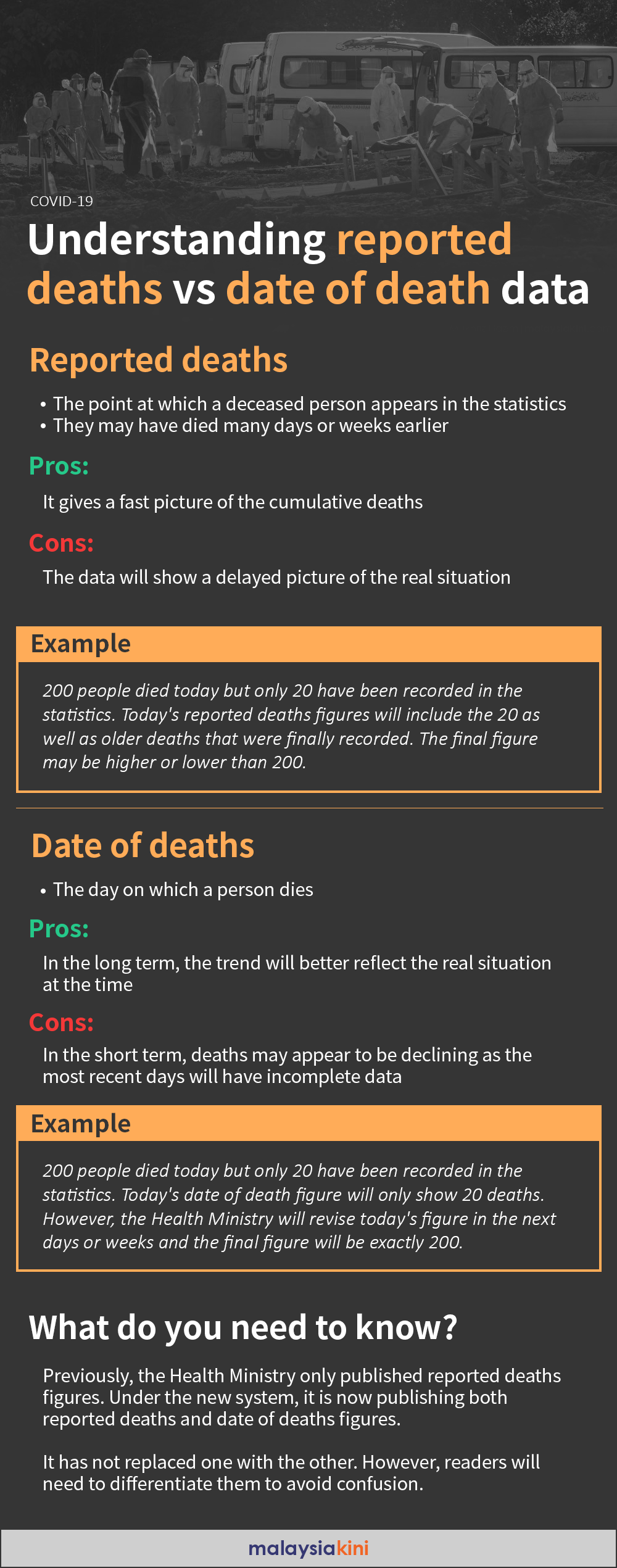Covid-19 deaths (Oct 1): 192 reported fatalities, Sarawak is epicentre of pandemic

COVID-19 | The Health Ministry’s Github data repository reported a total of 192 Covid-19 fatalities yesterday (Sept 30), bringing the national death toll to 26,335 – the worst in Asia in the number of deaths per capita.
The highest number of deaths was reported in Sarawak (40) which in recent days has seen record numbers of Covid-19 patients in intensive care.
Sarawak remains the only state in the country where Covid-19 hospital bed use was still on the uptrend over the past week.
According to the CovidNow website, new cases in Sarawak increased dramatically since August while sampling for Covid-19 in the state has dropped in September.
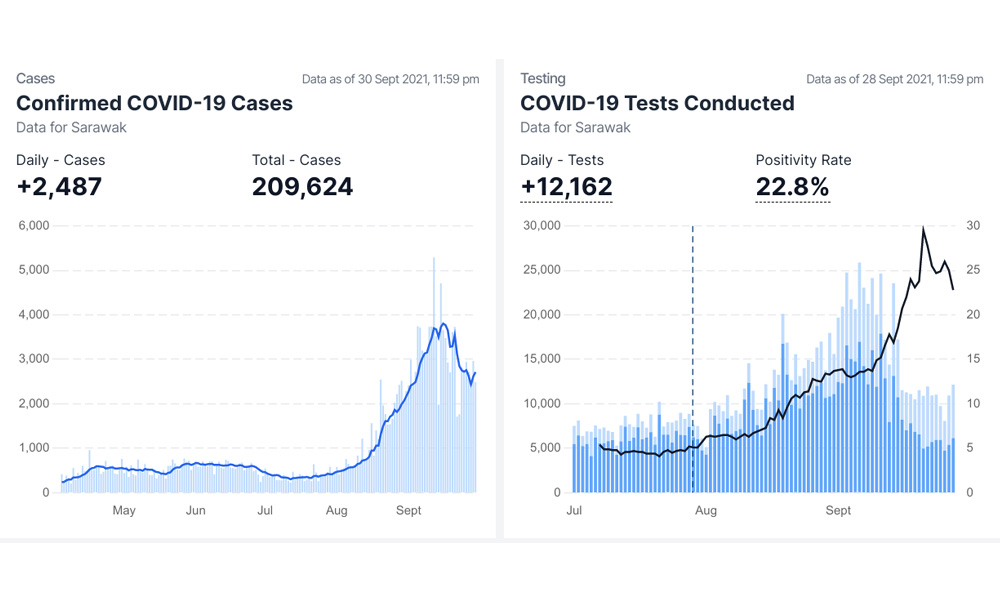
The remaining deaths were in Johor (34), Perak (23), Penang (21), Sabah (20), Selangor (18), Kedah (9), Terengganu (8), Kuala Lumpur (7), Malacca (4), Perlis (4), Negeri Sembilan (2), Kelantan (1) and Pahang (1).
No new deaths were reported in Labuan and Putrajaya.
A total of 145 out of the 192 reported deaths, or 75.5 percent, happened in the last seven days.
The remaining deaths happened more than a week ago but were only recorded yesterday due to delays in data reporting.
A total of 9,671 Covid-19 deaths were reported in September, 7,640 in August, 3,854 in July and 2,374 in June.
As of yesterday, there were 164,536 active Covid-19 cases. This is a reduction of 17.0 percent from the 198,284 active infections a week ago.
Compared to 30 days ago, the number of active cases has fallen by 38.6 percent from 267,866.
The Health Ministry’s post-midnight update also provided further insights into the new Covid-19 infections yesterday.
From the 12,735 new cases yesterday, a total of 764 of them could be traced to ongoing Covid-19 clusters.
From the cluster-linked cases, 432 (56.5 percent) were from workplaces while 294 (38.5 percent) were from community transmissions.
Another 24 (3.1 percent) were from clusters linked to high-risk groups such as old folks homes.
Previously, the Health Ministry released deaths statistics together with the number of new Covid-19 cases in the evening.
Deaths statistics are now released after midnight along with other more detailed data.
Covid-19 deaths (Sept 30): Another 208 fatalities, toll crosses 26,000

COVID-19 | The Health Ministry’s Github data repository reported a total of 208 Covid-19 fatalities yesterday (Sept 29), bringing the cumulative death toll to 26,143.
A total of 9,488 of those deaths, or more than a third, occurred in September alone, making this month the deadliest since the start of the pandemic, underscoring the country’s position as the worst in Asia in the number of Covid-19 deaths per capita.
In contrast, 7,642 Covid-19 deaths were reported in August, 3,858 in July, 2,380 in June and 1,302 in May.
From the newly reported deaths yesterday, 30.8 percent or 64 died before they could receive treatment at a hospital.
Selangor recorded the highest number of new deaths at 76, making up 36.5 percent of the newly reported fatalities.
The remaining deaths were in Johor (30), Penang (30), Sabah (22), Kedah (12), Kelantan (9), Perak (8), Terengganu (7), Pahang (4), Perlis (4), Kuala Lumpur (4) and Sarawak (2).
No new deaths were reported in Malacca, Negeri Sembilan, Labuan and Putrajaya.
The daily reported deaths have been above 200 for six consecutive days.
A total of 123 out of the 208 reported deaths or 59.1 percent occurred in the last seven days.
The remaining deaths took place more than a week ago but were only recorded yesterday due to delays in data reporting.
An average of 325 Covid-19 deaths was reported daily in the last 30 days, compared to the seven-day average of 225, indicating a downtrend.
As of yesterday, there were 169,718 active Covid-19 cases. This is a reduction of 15.7 percent from the 201,274 active infections a week ago.
Compared to 30 days ago, the number of active cases has fallen by 36.1 percent from 265,716.
Previously, the Health Ministry released death statistics together with the number of new Covid-19 cases in the evening. This had since changed.
Death statistics are now released after midnight, along with other more detailed data. Malaysiakini reports them in the morning.
Covid-19 (Sept 30): 12,735 cases, five states in four digits

COVID-19 | The Health Ministry reported 12,735 new Covid-19 cases today, bringing the cumulative infections to 2,245,695.
West Malaysia made up 9,254 of the fresh cases or 72.7 percent while East Malaysia contributed 3,481 or 27.3 percent.
In Peninsular Malaysia, the Klang Valley was responsible for 2,226 or 24.1 percent of the new infections while the remaining 7,028 cases or 75.9 percent came from outside of the region.
Sarawak topped the chart with 2,487 while Kedah, Kelantan and Perlis are seeing an uptick in new cases.
Kedah saw the highest number of new cases in 12 days (since Sept 18) while new infections in Kelantan and Perlis are the highest in a week.
On the flip side, Penang is making progress, recording the lowest number of fresh infections in 51 days, since Aug 10.
Today’s active cases and reported deaths will only be released after midnight. For yesterday’s figures, click here.
- Patients in ICU: 924 (849 confirmed; 75 suspected)
- Intubated: 512 (387 confirmed; 125 probable)
The number of new infections is surpassed by the 17,725 patients who recovered today. This is expected to help reduce the number of active cases.
As of today, the number of Covid-19 patients (including suspected ones) in the intensive care unit (ICU) is 17.3 percent lower compared to a week ago.
Those who require intubation have also declined by 16.7 percent from a week ago, which further relieves strain on the healthcare system.
New cases by states
Sarawak (2,487)
Selangor (1,940)
Johor (1,241)
Kelantan (1,232)
Kedah (1,033)
Sabah (993)
Perak (913)
Penang (763)
Terengganu (726)
Pahang (697)
Kuala Lumpur (258)
Malacca (194)
Negeri Sembilan (132)
Perlis (97)
Putrajaya (28)
Labuan (1)
Clusters
To date, 1,088 Covid-19 clusters are still active, including 15 new clusters reported today.
The ongoing clusters have fallen by 14.2 percent from the 1,268 active clusters a week ago. Overall, active clusters account for 764 (6.0 percnet) of today’s cases.
The 15 new clusters today comprised nine workplace clusters (60.0 percent), five community clusters (33.3 percent) and one clusters involving high-risk groups (6.7 percent).
Industri Batu 21 Jalan Pontian
Category: Workplace
States: Johor
District(s): Kulai
Initial tests: 26 out of 116 infected (22.4 percent)
Perusahaan Tanjung Labuh
Category: Workplace
States: Johor
District(s): Batu Pahat
Initial tests: 22 out of 38 infected (57.9 percent)
Industri Sri Tanjung
Category: Workplace
States: Johor
District(s): Tangkak and Muar
Initial tests: 10 out of 21 infected (47.6 percent)
Jalan Teknologi Dua Gopeng
Category: Workplace
States: Perak
District(s): Kampar and Kinta
Initial tests: 36 out of 155 infected (23.2 percent)
Tapak Bina Jalan Kamunting
Category: Workplace
States: Perak
District(s): Larut, Matang, and Selama
Initial tests: 20 out of 116 infected (17.2 percent)
Dua Jalan Puchong
Category: Workplace
States: Selangor
District(s): Petaling
Initial tests: 79 out of 318 infected (24.8 percent)
Industri Dua Anggerik Mokara 48
Category: Workplace
States: Selangor
District(s): Klang, Petaling, and Hulu Langat
Initial tests: 44 out of 113 infected (38.9 percent)
Dah Tapak Bina Padang
Category: Workplace
States: Kedah
District(s): Kulim
Initial tests: 30 out of 81 infected (37.0 percent)
Sungai Miang
Category: Workplace
States: Pahang
District(s): Pekan
Initial tests: 51 out of 121 infected (42.1 percent)
Kampung Padang Tok La Hilir
Category: Community
States: Kelantan
District(s): Pasir Mas
Initial tests: 13 out of 16 infected (81.2 percent)
Kampung Jejawi Alor Pasir
Category: Community
States: Kelantan
District(s): Pasir Mas
Initial tests: 11 out of 11 infected (100.0 percent)
Kampung Dalam Pupoh
Category: Community
States: Kelantan
District(s): Kota Bharu
Initial tests: 10 out of 15 infected (66.7 percent)
Kampung Simpang Tiga Banggol Petaling
Category: Community
States: Kelantan
District(s): Pasir Mas
Initial tests: 8 out of 10 infected (80.0 percent)
Long Pasia
Category: Community
States: Sabah
District(s): Sipitang
Initial tests: 25 out of 25 infected (100.0 percent)
Jalan Taib
Category: High-risk group
States: Johor
District(s): Kota Tinggi
Initial tests: 11 out of 85 infected (12.9 percent)
Source:Malaysiakini
Covid-19 (Sept 29): 12,434 new cases, 1,664 in Klang Valley

COVID-19 | The Health Ministry today reported 12,434 new Covid-19 cases.
New cases are trending down throughout the country, except in Sarawak where hospitalisations, ICU use and ventilator use continues to trend upwards.
Sarawak has the highest “incident rate” (new cases per 100,000 people) in the whole country followed by Kelantan, Penang and Perak.
As of yesterday, the R-naught for Malaysia has dropped to 0.88 – the lowest this month so far. A R-naught of less than 1.00 suggests that the spread of Covid-19 was decelerating.
Apart from Putrajaya and Terengganu, the R-naught is below 1.00 in other parts of the country.
Active cases and deaths will only be reported after midnight. For yesterday’s figures, click here.
- Patients in ICU: 979 [871 confirmed; 108 probable]
- Intubated: 565 [378 confirmed; 187 probable]
As of today, the number of Covid-19 patients in the intensive care unit (ICU) is 12.1 percent lower compared to a week ago.
Those who require intubation have also declined by 8.1 percent from a week ago.
New cases by states
Sarawak (2,967)
Selangor (1,362)
Johor (1,289)
Kelantan (1,125)
Sabah (1,000)
Perak (971)
Penang (863)
Pahang (663)
Kedah (652)
Terengganu (612)
Malacca (375)
Kuala Lumpur (284)
Negeri Sembilan (169)
Perlis (79)
Putrajaya (18)
Labuan (5)
Clusters
The Health Ministry is monitoring 1,124 active Covid-19 clusters, down 13.9 percent compared to one week ago.
Another 15 new clusters were classified today, which involved nine workplace clusters.
Perindustrian Firma Tebrau Satu
Category: Workplace
States: Johor
District(s): Johor Bahru
Initial tests: 54 out of 95 infected (56.8 percent)
Industri Jalan Mahsuri Kluang Dua
Category: Workplace
States: Johor
District(s): Kluang
Initial tests: 40 out of 410 infected (9.8 percent)
Jalan Desaru Penawar
Category: Workplace
States: Johor
District(s): Kota Tinggi
Initial tests: 22 out of 43 infected (51.2 percent)
Industri Sri Sulong 27
Category: Workplace
States: Johor
District(s): Batu Pahat
Initial tests: 16 out of 51 infected (31.4 percent)
Jalan Sri Aman 2
Category: Workplace
States: Kelantan
District(s): Pasir Puteh
Initial tests: 8 out of 15 infected (53.3 percent)
Lorong Minyak Gas
Category: Workplace
States: Kelantan
District(s): Kota Bharu and Pasir Mas
Initial tests: 7 out of 19 infected (36.8 percent)
Taman Baru Bera
Category: Workplace
States: Pahang
District(s): Bera and Temerloh
Initial tests: 27 out of 109 infected (24.8 percent)
Industri Dua Jalan Tiga Kompleks Perabut
Category: Workplace
States: Selangor
District(s): Kuala Langat and Klang
Initial tests: 14 out of 59 infected (23.7 percent)
Jalan Buku Lima
Category: Workplace
States: Kuala Lumpur
District(s): Titiwangsa
Initial tests: 10 out of 39 infected (25.6 percent)
Kampung Telaga Bata Sering
Category: Community
States: Kelantan
District(s): Kota Bharu
Initial tests: 10 out of 13 infected (76.9 percent)
Kampung Rasal Tok Uban
Category: Community
States: Kelantan
District(s): Pasir Mas
Initial tests: 8 out of 8 infected (100.0 percent)
Kampung Paloh Kubang Sepat
Category: Community
States: Kelantan
District(s): Pasir Mas
Initial tests: 7 out of 15 infected (46.7 percent)
Jalan Masjid Lati
Category: Community
States: Kelantan
District(s): Pasir Mas
Initial tests: 7 out of 7 infected (100.0 percent)
Paya Luas Kuala Krau
Category: Community
States: Pahang
District(s): Temerloh
Initial tests: 27 out of 42 infected (64.3 percent)
Mokodou
Category: Community
States: Sabah
District(s): Ranau
Initial tests: 94 out of 146 infected (64.4 percent)
Covid-19 (Sept 28): 11,332 new cases, R-naught below 1.00 in most states

COVID-19 | The Health Ministry has reported 11,332 new Covid-19 cases.
As of yesterday, the R-naught for the country has gone down to 0.90. The figure at the national level has been below 1.00 since Sept 1.
A R-naught of less than 1.00 suggests that the spread of Covid-19 was decelerating.
Pahang has a R-naught of 1.00. There are no states with a higher R-naught.
The latest daily sampling figures are not regularly available on the Health Ministry’s Github page.
Today’s active cases and reported deaths will only be released after midnight. For yesterday’s figures, click here.
- Patients in ICU: 986 (848 confirmed; 138 suspected)
- Intubated: 574 (369 confirmed; 205 probable)
As of today, the number of Covid-19 patients (including suspected ones) in the intensive care unit (ICU) is 11.6 percent lower compared to a week ago.
Those who require intubation have also declined by 9.6 percent from a week ago.
Cases by state
Sarawak (2,358)
Johor (1,319)
Selangor (1,231)
Kelantan (1,088)
Sabah (965)
Penang (895)
Kedah (819)
Perak (678)
Pahang (677)
Terengganu (629)
Malacca (303)
Kuala Lumpur (240)
Negeri Sembilan (89)
Putrajaya (19)
Perlis (19)
Labuan (3)
Clusters
To date, 1,151 Covid-19 clusters are still active, including 15 new clusters reported today.
The ongoing clusters have fallen by 12.5 percent from the 1,315 active clusters a week ago.
The 15 new clusters today comprised nine community (60.0 percent) and six workplace (40.0 percent).
Kampung Seneng
Category: Community
States: Kelantan
District(s): Bachok
Initial tests: 17 out of 28 infected (60.7 percent)
Kampung Serai Lima
Category: Community
States: Kelantan
District(s): Pasir Mas
Initial tests: 13 out of 14 infected (92.9 percent)
Kampung Kekabu Kuala Lemal
Category: Community
States: Kelantan
District(s): Pasir Mas dan Kota Bharu
Initial tests: 8 out of 8 infected (100.0 percent)
Kampung Ganoh
Category: Community
States: Pahang
District(s): Rompin
Initial tests: 23 out of 120 infected (19.2 percent)
Kampung Sungai Leleh
Category: Community
States: Pahang
District(s): Temerloh
Initial tests: 15 out of 35 infected (42.9 percent)
Kampung Kuala Boh
Category: Community
States: Pahang
District(s): Cameron Highlands
Initial tests: 15 out of 426 infected (3.5 percent)
Kampung Panchor Jelai
Category: Community
States: Negeri Sembilan
District(s): Jempol
Initial tests: 27 out of 77 infected (35.1 percent)
Parit Enam Timur
Category: Community
States: Selangor
District(s): Sabak Bernam
Initial tests: 10 out of 20 infected (50.0 percent)
Kerteh Enam Dungun
Category: Community
States: Terengganu
District(s): Dungun
Initial tests: 54 out of 129 infected (41.9 percent)
Tapak Bina Jalan Murni Empat
Category: Workplace
States: Johor
District(s): Kulai
Initial tests: 27 out of 57 infected (47.4 percent)
Perindustrian Jalan Ladang Siang
Category: Workplace
States: Johor
District(s): Kota Tinggi
Initial tests: 19 out of 36 infected (52.8 percent)
Industri Batu 29 Jalan Ipoh
Category: Workplace
States: Selangor
District(s): Hulu Selangor
Initial tests: 16 out of 55 infected (29.1 percent)
Industri Jalan Haji Abdul Karim 53
Category: Workplace
States: Selangor
District(s): Klang
Initial tests: 12 out of 25 infected (48.0 percent)
Jalan Tasik Gua Musang
Category: Workplace
States: Kelantan
District(s): Gua Musang
Initial tests: 24 out of 39 infected (61.5 percent)
Jalan Jambu Ipoh
Category: Workplace
States: Perak
District(s): Kinta
Initial tests: 20 out of 65 infected (30.8 percent)
Source:Malaysiakini
Sydney set to unveil freedom roadmap as more COVID-19 curbs eased
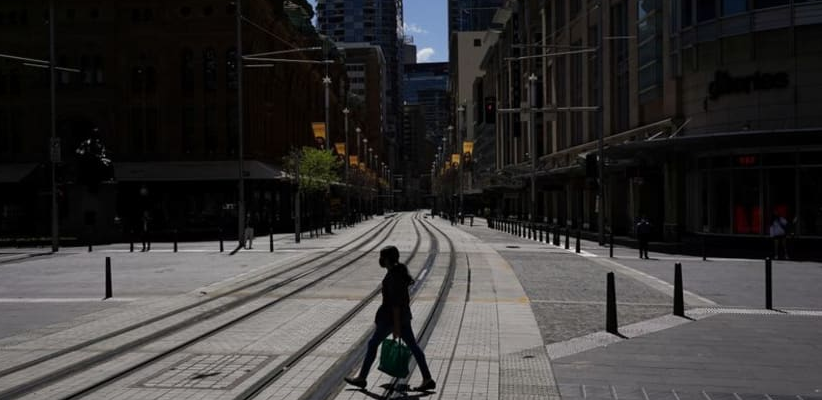
SYDNEY: Australia’s New South Wales government plans to unveil its roadmap on Monday (Sep 27) for reopening the state from COVID-19 shutdowns, detailing the differing levels of freedoms to be afforded to citizens based on their vaccination status.
With 60 per cent of people aged 16 and above fully inoculated – above the national average of 52 per cent – officials expect to reach their 80 per cent target around the end of October, based on current vaccination rates.
“You will be surprised at what will be announced,” Deputy Premier John Barilaro told 2GB radio. “If you want the freedoms we are talking about right across the board, you’re going to have to be vaccinated.”
The state began easing some restrictions on Monday, including in the capital Sydney, allowing construction sites to return to full capacity and outdoor swimming pools to reopen with social distancing measures in place.
Authorities on Sunday promised travel within the state will be permitted when the 80 per cent threshold is reached.
Australia is in the grip of a third wave of infections, fuelled by the highly infectious Delta variant, which has forced lockdowns in Sydney and Melbourne, its largest cities, and the capital Canberra.
The federal government’s national reopening scheme is predicated on Australia reaching a 70 to 80 per cent vaccination rate for its adult population. However, some virus-free states have said they may keep their borders closed even when that target is reached.
Victoria, home to Melbourne, is expected to relax some curbs from Wednesday when the state’s first-dose vaccination rate is forecast to tick more than 80 per cent. Officials reported 705 new cases in the state on Monday, the third straight day of decline, and one new death.
By closing its borders early in the pandemic, Australia managed the COVID-19 crisis better than many comparable countries. However, the arrival of the Delta variant in Sydney in June led to the country’s biggest surge in infections – about 68 per cent of its almost 100,000 cases have been reported since then.
The fatality rate, however, has slowed this year due to the higher vaccination levels among the most vulnerable. A total of 1,232 deaths have been registered.
Covid-19 deaths (Sept 27): 278 reported fatalities, total at 25,437

COVID-19 | The Health Ministry’s Github data repository reported a total of 278 Covid-19 fatalities yesterday (Sept 26), bringing the cumulative death toll to 25,437.
The daily reported deaths have been above 200 for 3 consecutive days.
From the newly reported deaths yesterday, 35.6 percent or 99 died before they could receive treatment at a hospital.
Selangor recorded the highest number of new deaths at 113, making up 40.6 percent of the newly reported fatalities.
The remaining deaths were in Johor (32), Penang (31), Kedah (27), Sabah (22), Kuala Lumpur (12), Kelantan (11), Sarawak (11), Perak (5), Terengganu (5), Malacca (4), Pahang (4) and Negeri Sembilan (1).
No new deaths were reported in Perlis, Labuan and Putrajaya.
A total of 149 out of the 278 reported deaths occurred in the last seven days.
The remaining deaths occurred more than a week ago but were only recorded yesterday due to delays in data reporting.
An average of 330 Covid-19 deaths were reported daily in the last 30 days compared to the seven-day average of 285, indicating a downtrend.
To date, 8,782 Covid-19 deaths have been reported this month.
A total of 7,642 Covid-19 deaths were reported in August, 3,858 in July, 2,380 in June and 1,302 in May.
As of yesterday, there were 183,289 active Covid-19 cases. This is a reduction of 12.9 percent from the 210,468 active infections a week ago.
Compared to 30 days ago, the number of active cases has fallen by 31.0 percent from 265,698.
The Health Ministry’s post-midnight update also provided further insights into the new Covid-19 infections yesterday.
From the 13,104 new cases yesterday, a total of 825 of them could be traced to ongoing Covid-19 clusters.
From the cluster-linked cases, 541 (65.6 percent) were from workplaces while another 222 (26.9 percent) were community transmission.
Another 51 (6.2 percent) were from clusters linked to education institutions.
The remaining cases were traced to clusters related to high-risk groups such as old folks home (6 – 0.7 percent), detention centres (5 – 0.6 percent), religious events (0 – 0.0 percent) and imported (0 – 0.0 percent).
Previously, the Health Ministry released deaths statistics together with the number of new Covid-19 cases in the evening. This had since changed.
Deaths statistics are now released after midnight along with other more detailed data. Malaysiakini reports them in the morning.
Source:Malaysiakini
New York may tap National Guard to replace COVID-19 unvaccinated healthcare workers
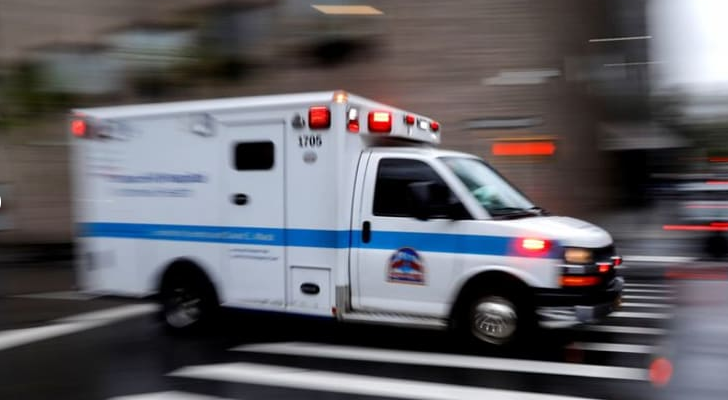
NEW YORK: New York Governor Kathy Hochul is considering employing the National Guard and out-of-state medical workers to fill hospital staffing shortages with tens of thousands of workers possibly losing their jobs for not meeting a Monday (Sep 27) deadline for mandated COVID-19 vaccination.
The plan, outlined in a statement from Hochul on Saturday, would allow her to declare a state of emergency to increase the supply of healthcare workers to include licensed professionals from other states and countries as well as retired nurses.
Hochul said the state was also looking at using National Guard officers with medical training to keep hospitals and other medical facilities adequately staffed. About 16 per cent of the state’s 450,000 hospital staff, or roughly 72,000 workers, have not been fully vaccinated, the governor’s office said.
The plan comes amid a broader battle between state and federal government leaders pushing for vaccine mandates to help counter the highly infectious Delta variant of the novel coronavirus and workers who are against inoculation requirements, some objecting on religious grounds.
Hochul attended the Sunday service at a large church in New York City to ask Christians to help promote vaccines.
“I need you to be my apostles. I need you to go out and talk about it and say, we owe this to each other,” Hochul told congregants at the Christian Cultural Center in Brooklyn, according to an official transcript.
“Jesus taught us to love one another and how do you show that love but to care about each other enough to say, please get the vaccine because I love you and I want you to live.”
Healthcare workers who are fired for refusing to get vaccinated will not be eligible for unemployment insurance unless they are able to provide a valid doctor-approved request for medical accommodation, Hochul’s office said.
It was not immediately clear how pending legal cases concerning religious exemptions would apply to the state’s plan to move ahead and terminate unvaccinated healthcare workers.
A federal judge in Albany temporarily ordered New York state officials to allow religious exemptions for the state-imposed vaccine mandate on healthcare workers, which was put in place by former Governor Andrew Cuomo and takes effect on Monday.
A requirement for New York City school teachers and staff to get vaccinated was temporarily blocked by a US appeals court just days before it was to take effect. A hearing is set for Wednesday.
The highly transmissible Delta variant has driven a surge in COVID-19 cases and hospitalisations in the United States that peaked in early September and has since fallen, according to a Reuters tally. Deaths, a lagging indicator, continue to rise with the nation reporting about 2,000 lives lost on average a day for the past week, mostly in the unvaccinated.
While nationally cases are down about 25 per cent from their autumn peak, rising new infections in New York have only recently levelled off, according to a Reuters tally.
In an attempt to better protect the most vulnerable, the CDC on Friday backed a booster shot of the Pfizer-BioNTech COVID-19 vaccine for Americans aged 65 and older, adults with underlying medical conditions and adults in high-risk working and institutional settings.
On Sunday, CDC Director Dr Rochelle Walensky fleshed out who should be eligible for the booster shots based on their work in high-risk settings.
“That includes people in homeless shelters, people in group homes, people in prisons, but also importantly, our people who work … with vulnerable communities,” Walensky said during a TV interview. “So our health care workers, our teachers, our grocery workers, our public transportation employees.”
Walensky decided to include a broader range of people than was recommended on Thursday by a group of expert outside advisers to the agency. The CDC director is not obliged to follow the advice of the panel.
Serbian troops on heightened alert at Kosovo border
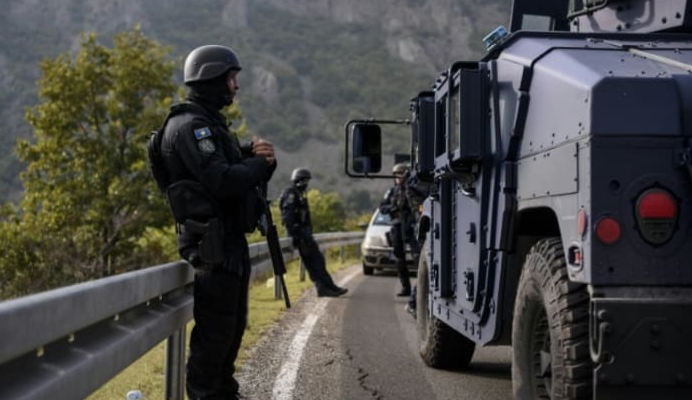
BELGRADE: Serbian troops were on a heightened state of alert on Sunday (Sep 26) after the government in Belgrade accused neighbouring Kosovo of “provocations” by sending special police units to the border.
Already tense relations between Serbia and its former breakaway region have grown worse since the ethnic Albanian-led government there on Monday despatched the police units to an area mainly populated by minority ethnic Serbs, who reject the authority of the government in Kosovo’s capital Pristina.
The deployment came as hundreds of ethnic Serbs have staged daily protests against a decision to require drivers with Serbian registration plates to put on temporary ones when entering Kosovo – a “reciprocal measure”, according to Pristina.
“No one here wants a conflict and I hope there won’t be one,” said a 45-year-old protester who identified himself as Ljubo and was camped at the Jarinje border crossing.
“We want Pristina to withdraw its forces and cancel the decision on licence plates.”
Hundreds of Serbs in Kosovo have been protesting and blocking traffic with trucks on the roads leading to two border crossings.
“After the provocations by the (special police) units … Serbian President Aleksandar Vucic gave the order to heighten the alert for some Serbian army and police units,” the defence ministry in Belgrade said in a statement.
Serbian fighter jets could again be seen overflying the border region on Sunday after several sorties on Saturday, an AFP correspondent reported.
DIPLOMATIC PRESSURE
The European Union’s chief diplomat Josep Borrell urged Serbia and Kosovo to reduce tensions “by immediately withdrawing special police units and dismantling of roadblocks”.
“Any further provocations or unilateral and uncoordinated actions are unacceptable,” he said in a statement.
NATO Secretary-General Jens Stoltenberg said he had spoken by phone to the Serbian president and Kosovar Prime Minister Albin Kurti.
“It’s vital both Belgrade and Pristina show restraint and return to dialogue”, he tweeted.
NATO troops have been deployed in Kosovo since the 1998-99 Serbian-Kosovar conflict.
Belgrade does not recognise Kosovo’s unilateral declaration of independence in 2008 and sees Pristina’s decision on the licence plates as implying its status as a sovereign state.
The Serbian head of state, Aleksandar Vucic, deplored the lack of reaction from the international community to “the total occupation for more than a week of northern Kosovo by Pristina’s armoured vehicles”.
“And everyone is suddenly worried when Serbian helicopters and planes are seen over central Serbia,” Vucic said in a statement, adding, however, that Serbia “will always behave responsibly and seriously”.
Kosovar Prime Minister Albin Kurti on Saturday accused Serbia of wanting to “provoke a serious international conflict”.
Early on Sunday, Serbian Defence Minister Nebojsa Stefanovic visited troops at two military bases where they are on alert, including one that is just a few kilometres from the border.
Belgrade designates border crossings between Serbia and Kosovo as “administrative”.
Serbian ally Russia also does not recognise Kosovo’s independence, but most Western countries do, including the United States.
For its part, NATO member Albania, “concerned by the escalation of the situation”, has asked Belgrade “to withdraw the armed forces deployed on the border with Kosovo”.
Kosovo President Vjosa Osmani cut short a visit to New York for the UN general assembly “because of developments in the north of the country”, her cabinet said.
Kosovo’s declaration of independence came a decade after a war between ethnic Albanian guerrillas and Serbian forces that claimed 13,000 lives, mostly ethnic Albanians.
The United States and the European Union have called for a de-escalation of tensions and for the two sides to return to normalisation talks, which the EU has mediated for about a decade.
The Serbian president said the normalisation process can resume only if Kosovo withdraws the special police forces from the north.
Sydney set to unveil freedom roadmap as more COVID-19 curbs eased
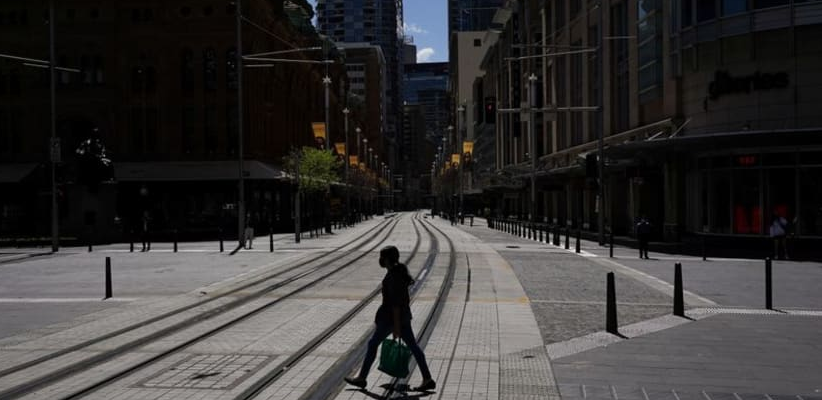
SYDNEY: Australia’s New South Wales government plans to unveil its roadmap on Monday (Sep 27) for reopening the state from COVID-19 shutdowns, detailing the differing levels of freedoms to be afforded to citizens based on their vaccination status.
With 60 per cent of people aged 16 and above fully inoculated – above the national average of 52 per cent – officials expect to reach their 80 per cent target around the end of October, based on current vaccination rates.
“You will be surprised at what will be announced,” Deputy Premier John Barilaro told 2GB radio. “If you want the freedoms we are talking about right across the board, you’re going to have to be vaccinated.”
The state began easing some restrictions on Monday, including in the capital Sydney, allowing construction sites to return to full capacity and outdoor swimming pools to reopen with social distancing measures in place.
Authorities on Sunday promised travel within the state will be permitted when the 80 per cent threshold is reached.
Australia is in the grip of a third wave of infections, fuelled by the highly infectious Delta variant, which has forced lockdowns in Sydney and Melbourne, its largest cities, and the capital Canberra.
The federal government’s national reopening scheme is predicated on Australia reaching a 70 to 80 per cent vaccination rate for its adult population. However, some virus-free states have said they may keep their borders closed even when that target is reached.
Victoria, home to Melbourne, is expected to relax some curbs from Wednesday when the state’s first-dose vaccination rate is forecast to tick more than 80 per cent. Officials reported 705 new cases in the state on Monday, the third straight day of decline, and one new death.
By closing its borders early in the pandemic, Australia managed the COVID-19 crisis better than many comparable countries. However, the arrival of the Delta variant in Sydney in June led to the country’s biggest surge in infections – about 68 per cent of its almost 100,000 cases have been reported since then.
The fatality rate, however, has slowed this year due to the higher vaccination levels among the most vulnerable. A total of 1,232 deaths have been registered.

